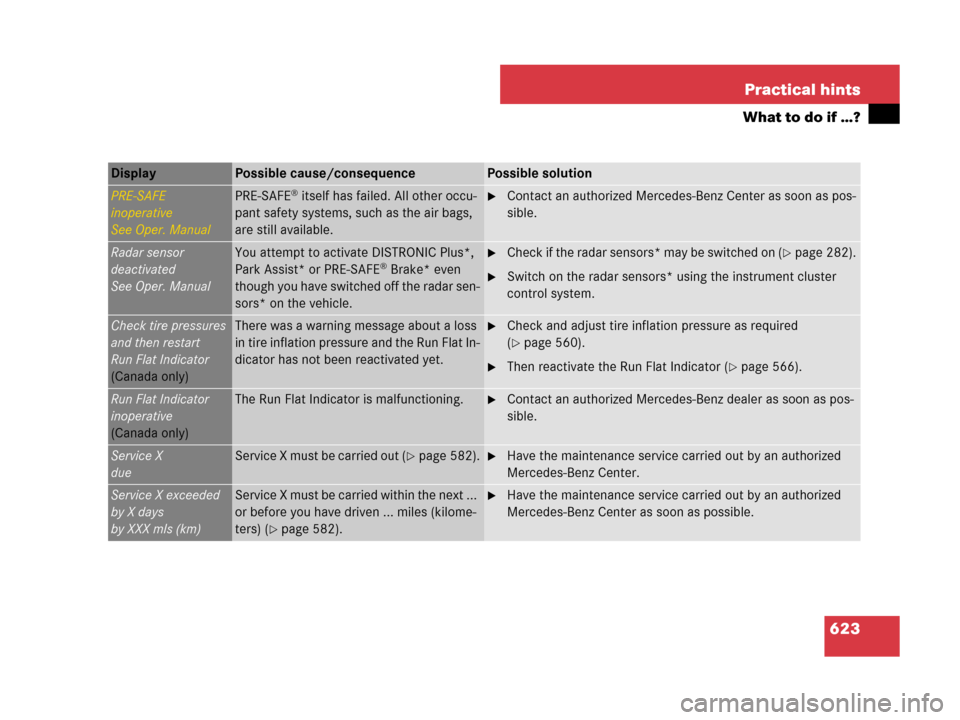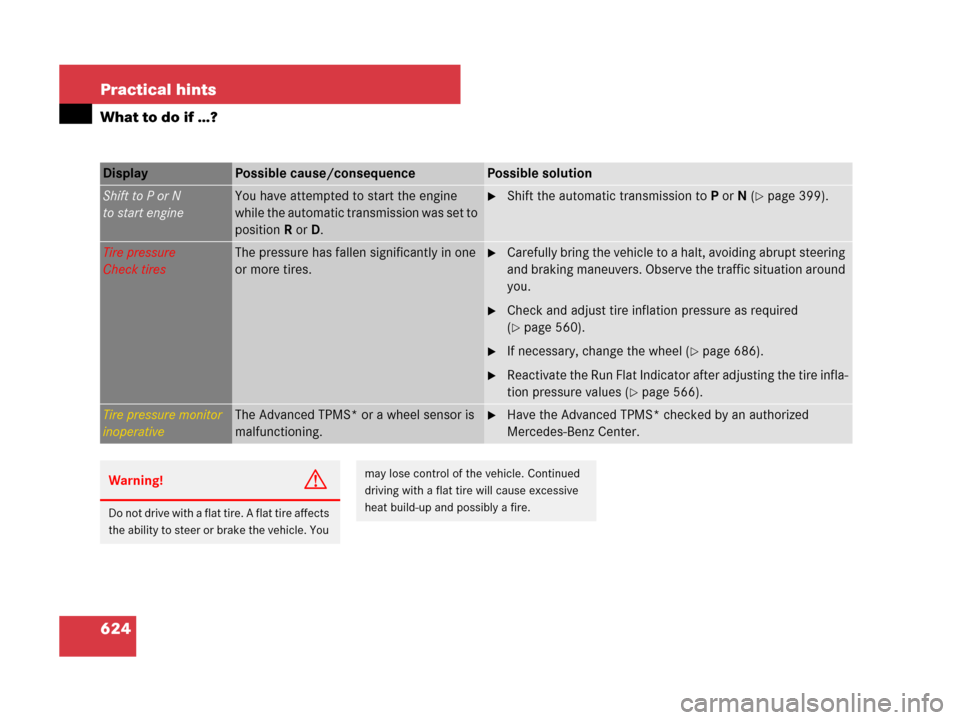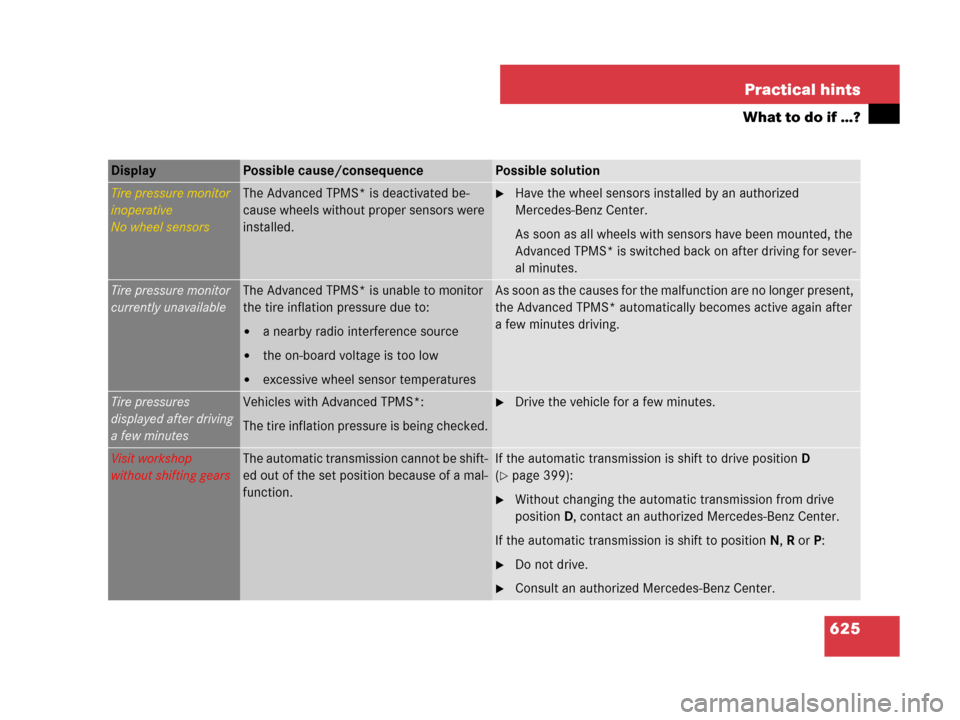Page 610 of 761

609 Practical hints
What to do if …?
Warning!G
Each tire, including the spare (if provided),
should be checked monthly when cold and
inflated to the inflation pressure recom-
mended by the vehicle manufacturer on the
vehicle placard or the tire inflation pressure
label. (If your vehicle has tires of a different
size than the size indicated on the vehicle
placard or the tire inflation pressure label,
you should determine the proper tire infla-
tion pressure for those tires).
As an added safety feature, your vehicle has
been equipped with a tire pressure monitor-
ing system (TPMS) that illuminates a low tire
pressure telltale when one or more of your
tires is significantly under-inflated. Accord-
ingly, when the low tire pressure telltale illu-
minates, you should stop and check your
tires as soon as possible, and inflate them to
the proper pressure. Driving on a significant-
ly under-inflated tire causes the tire to over-
heat and can lead to tire failure.
Under-inflation also reduces fuel efficiency
and tire tread life, and may affect the vehi-
cle’s handling and stopping ability. Please
note that the TPMS is not a substitute for
proper tire maintenance, and it is the driv-
er’s responsibility to maintain correct tire
pressure, even if under-inflation has not
reached the level to trigger illumination of
the TPMS low tire pressure telltale.
USA only:
Your vehicle has also been equipped with a
TPMS malfunction indicator to indicate
when the system is not operating properly.
The TPMS malfunction indicator is com-
bined with the low tire pressure telltale.
When the system detects a malfunction, the
telltale will flash for approximately
one minute and then remain continuously
illuminated. This sequence will continue
upon subsequent vehicle start-ups as long
as the malfunction exists. When the mal-
function indicator is illuminated, the system
may not be able to detect or signal low tire
pressure as intended.TPMS malfunctions may occur for a variety
of reasons, including the installation of
replacement or alternate tires or wheels on
the vehicle that prevent the TPMS from
functioning properly. Always check the
TPMS malfunction telltale after replacing
one or more tires or wheels on your vehicle
to ensure that the replacement or alternate
tires and wheels allow the TPMS to continue
to function properly.
Page 624 of 761

623 Practical hints
What to do if …?
Display Possible cause/consequencePossible solution
PRE-SAFE
inoperative
See Oper. ManualPRE-SAFE® itself has failed. All other occu-
pant safety systems, such as the air bags,
are still available.�Contact an authorized Mercedes-Benz Center as soon as pos-
sible.
Radar sensor
deactivated
See Oper. ManualYou attempt to activate DISTRONIC Plus*,
Park Assist* or PRE-SAFE® Brake* even
though you have switched off the radar sen-
sors* on the vehicle.
�Check if the radar sensors* may be switched on (�page 282).
�Switch on the radar sensors* using the instrument cluster
control system.
Check tire pressures
and then restart
Run Flat Indicator
(Canada only)There was a warning message about a loss
in tire inflation pressure and the Run Flat In-
dicator has not been reactivated yet.�Check and adjust tire inflation pressure as required
(
�page 560).
�Then reactivate the Run Flat Indicator (�page 566).
Run Flat Indicator
inoperative
(Canada only)The Run Flat Indicator is malfunctioning.�Contact an authorized Mercedes-Benz dealer as soon as pos-
sible.
Service X
dueService X must be carried out (�page 582).�Have the maintenance service carried out by an authorized
Mercedes-Benz Center.
Service X exceeded
by X days
by XXX mls (km)Service X must be carried within the next ...
or before you have driven ... miles (kilome-
ters) (
�page 582).
�Have the maintenance service carried out by an authorized
Mercedes-Benz Center as soon as possible.
Page 625 of 761

624 Practical hints
What to do if …?
Display Possible cause/consequencePossible solution
Shift to P or N
to start engineYou have attempted to start the engine
while the automatic transmission was set to
position R or D.�Shift the automatic transmission to P or N (�page 399).
Tire pressure
Check tiresThe pressure has fallen significantly in one
or more tires.�Carefully bring the vehicle to a halt, avoiding abrupt steering
and braking maneuvers. Observe the traffic situation around
you.
�Check and adjust tire inflation pressure as required
(
�page 560).
�If necessary, change the wheel (�page 686).
�Reactivate the Run Flat Indicator after adjusting the tire infla-
tion pressure values (
�page 566).
Tire pressure monitor
inoperativeThe Advanced TPMS* or a wheel sensor is
malfunctioning.�Have the Advanced TPMS* checked by an authorized
Mercedes-Benz Center.
Warning!G
Do not drive with a flat tire. A flat tire affects
the ability to steer or brake the vehicle. You
may lose control of the vehicle. Continued
driving with a flat tire will cause excessive
heat build-up and possibly a fire.
Page 626 of 761

625 Practical hints
What to do if …?
Display Possible cause/consequencePossible solution
Tire pressure monitor
inoperative
No wheel sensorsThe Advanced TPMS* is deactivated be-
cause wheels without proper sensors were
installed.�Have the wheel sensors installed by an authorized
Mercedes-Benz Center.
As soon as all wheels with sensors have been mounted, the
Advanced TPMS* is switched back on after driving for sever-
al minutes.
Tire pressure monitor
currently unavailableThe Advanced TPMS* is unable to monitor
the tire inflation pressure due to:
�a nearby radio interference source
�the on-board voltage is too low
�excessive wheel sensor temperatures
As soon as the causes for the malfunction are no longer present,
the Advanced TPMS* automatically becomes active again after
a few minutes driving.
Tire pressures
displayed after driving
a few minutesVehicles with Advanced TPMS*:
The tire inflation pressure is being checked.�Drive the vehicle for a few minutes.
Visit workshop
without shifting gearsThe automatic transmission cannot be shift-
ed out of the set position because of a mal-
function.If the automatic transmission is shift to drive positionD
(
�page 399):
�Without changing the automatic transmission from drive
positionD, contact an authorized Mercedes-Benz Center.
If the automatic transmission is shift to positionN, R or P:
�Do not drive.
�Consult an authorized Mercedes-Benz Center.
Page 665 of 761

664 Practical hints
What to do if …?
Display Possible cause/consequencePossible solution
Tele Aid
inoperativeOne or more main functions of the Tele Aid
system are malfunctioning.�Have the Tele Aid system checked by an au-
thorized Mercedes-Benz Center.
Tire pressure
Caution, tire defectVehicles with Advanced TPMS*:
One or more tires are deflating.�Carefully bring the vehicle to a halt, avoiding
abrupt steering and braking maneuvers.
�Engage the electronic parking brake
(
�page 395).
�If necessary, change the wheel (�page 686).
Caution
Tire defectVehicles with Advanced TPMS*:
One or more tires are deflating. The respec-
tive tire is shown in the multifunction dis-
play.�Carefully bring the vehicle to a halt, avoiding
abrupt steering and braking maneuvers.
�Engage the electronic parking brake
(
�page 395).
�If necessary, change the wheel (�page 686).
Warning!G
Do not drive with a flat tire. A flat tire affects
the ability to steer or brake the vehicle. You
may lose control of the vehicle. Continued
driving with a flat tire will cause excessive
heat build-up and possibly a fire.
Page 666 of 761

665 Practical hints
What to do if …?
Display Possible cause/consequencePossible solution
Tire pressure
Check tiresVehicles with Advanced TPMS*:
The pressure is too low in one or more tires.�Carefully bring the vehicle to a halt, avoiding
abrupt steering and braking maneuvers.
�Engage the electronic parking brake
(
�page 395).
�Check and adjust tire inflation pressure as
required (
�page 561).
�If necessary, change the wheel (�page 686).
Check tiresVehicles with Advanced TPMS*:
The pressure is too low in one or more tires.
The respective tire is shown in the multi-
function display.�Carefully bring the vehicle to a halt, avoiding
abrupt steering and braking maneuvers.
�Engage the electronic parking brake
(
�page 395).
�Check and adjust tire inflation pressure as
required (
�page 561).
�If necessary, change the wheel (�page 686).
Warning!G
Do not drive with a flat tire. A flat tire affects
the ability to steer or brake the vehicle. You
may lose control of the vehicle. Continued
driving with a flat tire will cause excessive
heat build-up and possibly a fire.
Page 667 of 761
666 Practical hints
What to do if …?
Display Possible cause/consequencePossible solution
Wheel sensor(s)
missingOne or more sensors malfunction (e.g. bat-
tery in one or more wheel sensor is empty).
One or more wheels without wheel sensors
mounted (e.g. spare tire).
No pressure value is shown on the multi-
function display for the tire in question.�Have the Advanced TPMS* checked by an
authorized Mercedes-Benz Center.
�Have the wheel sensors installed by an
authorized Mercedes-Benz Center.
The tire pressure for the respective tire is
shown in the multifunction display after a few
minutes driving.
Tire pressure
Please rectifyVehicles with Advanced TPMS*:
The pressure is too low in one or more tires.
Or the tire pressures of the individual
wheels differ too radically from one anoth-
er.�Check and adjust tire inflation pressure as
required (
�page 561).
Page 687 of 761

686 Practical hints
Flat tire
Preparing the vehicle
�Park the vehicle in a safe distance from
moving traffic on a hard, flat surface
when possible.
�Turn on the hazard warning flasher
(
�page 377).
�Turn the steering wheel so that the
front wheels are in a straight ahead
position.
�Shift the automatic transmission to
park positionP.
�Engage the electronic parking brake.
�Turn off the engine.
�Have any passenger exit the vehicle at
a safe distance from the roadway.
�Vehicles with SmartKey: Remove the
SmartKey from the starter switch.
Vehicles with KEYLESS-GO*: Open the
driver’s door (this puts the starter
switch in position0, same as with the
SmartKey removed from the starter
switch). The driver’s door then can be
closed again.
�Remove the KEYLESS-GO*
start/stop button from the starter
switch.
Mounting the spare wheel
iOpen the door only when conditions are safe
to do so.
Warning!G
The dimensions of the spare wheel are dif-
ferent from those of the road wheels. As a
result, the vehicle handling characteristics
change when driving with a spare wheel
mounted. Adapt your driving style accord-
ingly.
The spare wheel is for temporary use only.
When driving with spare wheel mounted,
ensure proper tire inflation pressure and
do not exceed a vehicle speed
of 50 mph (80 km/h).
Contact the nearest Mercedes-Benz Center
as soon as possible to have the spare wheel
replaced with a regular road wheel.
Never operate the vehicle with more than
one spare wheel mounted.
Do not switch off the ESP
® when a spare
wheel is mounted.